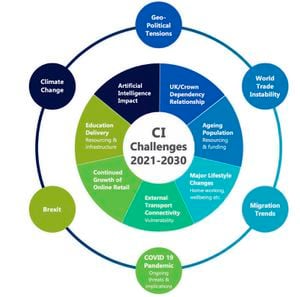Together, we might just revive and thrive
Hang on, if Aurigny operates in a sub-optimal market, what does that say about Guernsey’s own economies of scale? Not much, according to a new report. Which is why we need good neighbours more than ever, says Richard Digard

THOSE of you with good memories might recall that from time to time I’ve wondered out loud whether there’s a minimum size below which communities cannot realistically hope to continue as independent, self-governing islands.
Sark, with perhaps fewer than 400 year-round residents and challenges including elections, electricity, social care and healthcare, education and no civil service, has already been threatened with virtual extinction by the Ministry of Justice.
Alderney, with a population of around 2,000, is effectively administered from Guernsey under the post-war transferred services agreement and still receives massive subsidies from Guernsey taxpayers – on a per capita basis it’s the equivalent here to a top-up of around £250m. or so.
Simple logic, therefore, suggests things like critical mass – an island’s very existence not being reliant on external support – and economies of scale must apply.
After all, we’re all on board now with the argument that Aurigny is loss making as it operates in sub-optimal markets because of Guernsey’s population.
So, is there a ‘Goldilocks’ island size which is just right in terms of area, population levels, economic profile, social infrastructure and wellbeing, fiscal performance and thus pretty much guaranteed to be able to paddle its own canoe no matter what?
I’d like to be able to say yes, but it’s more nuanced than that.
That said, Critical Economics, a new consultancy specialising in helping small communities secure their future through economies of scale, have used the Channel Islands as a case study.
With a combined population of 173,000, public sector expenditure well in excess of £1bn a year and some significant capital infrastructure projects like a new hospital, secondary schools and rehabilitation of harbours and runway mooted, it’s an ideal subject.
The reason, of course, is that those people are spread over four main islands – Jersey and Guernsey, the two biggest, with 108,000 and 63,000 respectively – but all with separate systems of government and each independently and separately providing community critical public services while being just 20 miles apart. Daft when you look at it that way.
More fundamentally, an analysis of the islands’ economic lifecycles shows that Jersey and Guernsey really started to diverge from the 1970s onwards, primarily driven by different economic factors and the policies adopted by each of the islands.
Jersey, for example, has leveraged its bigger size.

So while the overall CI population is 40% bigger than it was in 1971, Jersey’s rose by 38,500 people or 55%, but Guernsey’s by just 23% or 11,700 people.
That’s neither good nor bad, just a way of pointing out that there are consequences.
‘Merger and consolidation of many Guernsey – and Jersey-based companies takes place with more “headquarter” emphasis in Jersey. Inter-island air connectivity deteriorates to the detriment of Guernsey economy.
Jersey able to embrace low-cost air travel market. Jersey relaxes immigration policy.
‘Online shopping has a detrimental effect on traditional retail market and employment levels. Guernsey construction sector contracts due to lack of public and private sector building projects,’ notes Critical Economics of the last 10 years.
Talking of people, 50-59-year-olds now represent the peak age band in both islands, a rise of nearly 80%. Back in 1971, Guernsey’s largest age group was the under nines and in Jersey it was 20-29-year-olds.
Look to Alderney, and its peak age group is 70-79.
Meanwhile, the private sector understands critical mass and economies of scale, either to retain or improve competitiveness and win cost savings. Which is why there have been so many mergers and acquisitions following 2008’s Great Crash. And only this week PraxisIFM Group and Oak Group, two of Guernsey’s biggest financial services firms, announced plans to combine their global businesses.
Other factors affecting business, however, have included the reduction in the quality of inter-island travel, growth in the use of IT and artificial intelligence, the varying pace of economic development in each island, the need to achieve economies of scale by providing a broader skills base within the organisation and increasing overall buying power.
Specifically, says Critical Economics, ‘one resultant trend is the migration of current and new business away from Guernsey in favour of Jersey as the CI hub'.
That’s been driven by much better air transport connectivity to and from Jersey, the lower cost of travel there, more flexible labour/immigration policies in Jersey than in Guernsey and more land, which has enabled a rapid expansion of business premises to occur and private household accommodation to be constructed, it says.
Put that another way, despite the similarities between the islands and common interests, the two most destructive events since the Second World War – the 2008 financial crisis and 2020 Covid-19 pandemic – have seen Jersey and Guernsey working apart while each is trying to address the same associated challenges but in isolation.
To take a single issue, each island has an ageing population which will demand more resources, including staff, just when Guernsey and Jersey need as many people as possible working in high wage sectors to increase tax revenues. In that context, why duplicate care facilities when pan-island solutions are available?
Changes in work practices and lifestyle choices are, post-Covid, only accelerating. And that’s before factoring in the growth of artificial intelligence. Arguably, says Critical Economics, this is one the most important areas which should be dealt with on a pan-CI basis.
‘A policy of the free movement (physically and virtually) within the CI of economically active persons should be given real thought.’
These won’t be popular suggestions in some quarters – Little Englander-type tendencies remain strong in both islands – but they are timely. What’s yet to be recognised is that this community’s aspirations have exceeded their abilities to pay for them.
A population of 63,000 cannot have a health service equivalent to that in the UK. The laws of critical mass and economies of scale can only be deferred while the money lasts. And, as we’ve noted previously, that’s just run out.
What a community of 173,000 people can afford, however, is a different matter and is vividly illustrated by the differences in the quality and price of the respective air services, as Critical Economics has highlighted.
‘Given the relentless increase in costs associated with the need to resource rising public expectations on the quality of services generally, the luxury of having separately administered public services in each of the main Channel Islands becomes hard to justify,’ it says. This is even more the case given the challenges that the world, let alone the Channel Islands, now faces over the next 20 years.
‘On the other hand, the Channel Islands as a whole have a real opportunity to see where there are public sector opportunities to pursue on a pan-CI basis,’ it goes on.
All I’d add is there’s now a pressing need to do so.





